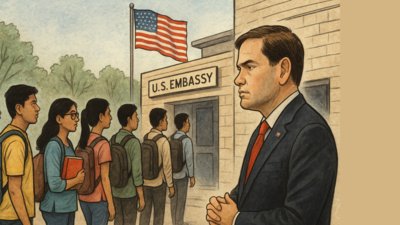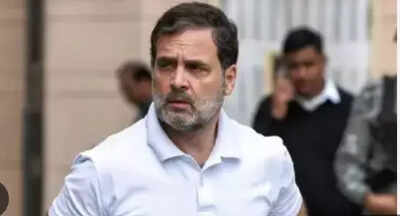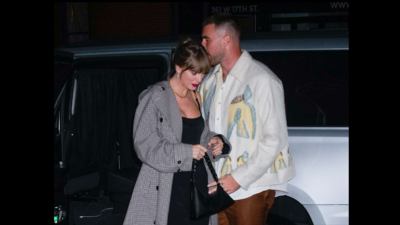Indian students trapped in the waiting room of their American dreams: Will Marco Rubio unlock the door?

For thousands of Indian students admitted to American universities this fall, the flight to the U.S. may as well be grounded before it takes off—not because of finances or admission hurdles, but because the visa window has slammed shut. A crisis is unfolding across U.S. consulates in India, leaving students in bureaucratic limbo even as tuition deadlines loom and housing contracts run their course. What began as a quiet backlog has now spiralled into a diplomatic flashpoint, with lawmakers on Capitol Hill calling it what it is: a systemic failure that threatens to choke U.S. higher education’s single largest international talent pipeline.Since June 18, 2025, that pipeline has been throttled by a sudden reduction in student visa appointment capacity, as American consulates rolled out new online social media screening norms demanding applicants disclose five years’ worth of digital identifiers. The added scrutiny paused scheduling for weeks and left interview slots painfully scarce, marooning thousands of Indian students—many clutching confirmed admissions and I‑20 forms—as the fall semester nears and their academic futures hang in uncertainty.
Congressional alarm bells: Letters to Marco Rubio
On 24 July 2025, Congresswoman Deborah Ross, backed by 14 other House members—including Indian-American representatives Pramila Jayapal, Raja Krishnamoorthi, and Shri Thanedar—sent a bipartisan letter to Secretary of State Marco Rubio. The letter, with a response deadline of 8 August, urges the immediate restoration of full student visa processing capacity across India’s U.S. missions. The lawmakers warn that, without intervention, tens of thousands of Indian students may miss their semester start dates, jeopardising not only academic opportunities but also billions in contributions to the U.S. economy.This follows an earlier May 2025 appeal by the American Council on Education (ACE) and over 50 education associations, protesting a temporary pause in student visa interviews tied to the rollout of enhanced social media vetting protocols. Universities and lawmakers now warn that this procedural bottleneck is no longer a minor hiccup—it is becoming a structural impediment to U.S.–India educational exchange.
The numbers paint a bleak picture
The gravity of the problem emerges in State Department data:
- March–May 2025: F‑1 visa issuances to Indian students dropped 27% year-on-year, sliding from 13,478 in 2024 to 9,906 this spring.
- January–September 2024: A 38% decline compared to 2023, with 64,008 visas issued versus 103,495 the previous year.
- First half of FY25 (Oct 2024–Mar 2025): Issuances were down 43.5%, with fewer than 15,000 approvals.
India is now the largest source of international students in the U.S., overtaking China with 29% of the 24,468 students in North Carolina alone in 2024, per the Institute of International Education. Nationwide, over 250,000 Indian students contribute an estimated $9 billion annually in tuition and living expenses. Yet this academic lifeline is being throttled by administrative bottlenecks, leaving students stranded.
How it feels on the ground: The student fallout
Beyond numbers, the impact on Indian students is profound and multi-layered:
- Deferred Dreams: Thousands report receiving appointment slots well past university reporting dates, forcing deferrals to 2026. Some risk losing scholarships tied to fall enrolment.
- Financial Burn: Families have already paid non-refundable deposits on tuition, flights, and accommodation. For middle-class households, where foreign education is financed through loans, each passing month adds interest without certainty of departure.
- Academic Disruption: In research-intensive fields like STEM, delayed arrival means missing lab rotations, orientation sessions, and teaching assistantships, disrupting long-term career trajectories.
- Psychological Toll: Education consultancies report rising stress and anxiety among students, with many scrambling for Canadian or European options as backup. For first-generation learners, the uncertainty translates into fear of losing once-in-a-lifetime opportunities.
- Knock-on Effect on Universities: U.S. campuses rely heavily on Indian students for graduate research output, particularly in engineering and computer science departments. Delays threaten not just enrolment numbers but ongoing funded research projects dependent on international graduate assistants.
Why the bottleneck?
Three converging forces have turned America’s most coveted student visa into one of its hardest to secure.A New Digital Gatekeeper: On June 18, 2025, U.S. consulates quietly rewired the screening process, demanding applicants hand over five years’ worth of social media handles. The added scrutiny slammed the brakes on interview allocations, leaving thousands of hopeful students staring at “no appointments available” screens during the most crucial weeks of the season.A System Running on Half Power: When bookings resumed, it wasn’t a floodgate but a trickle. Consulates across India continued to process visas at throttled capacity, unable to catch up with the summer surge. Every day lost pushes departure dates closer to impossibility, tuition deposits closer to forfeiture.History Repeating in a New Accent: Veterans of U.S. immigration policy recall a similar squeeze during the 2018–19 U.S.–China trade war, when F‑1 visas and post-study OPT permissions slowed under a different political pretext. India’s current crisis is framed as security protocol, not geopolitical retaliation—but for students caught in limbo, the distinction is academic.
The ripple effect of a jammed visa system
The fallout from America’s choked student visa pipeline doesn’t stop at airport check-ins or abandoned housing contracts—it reverberates through boardrooms, classrooms, and diplomatic channels.An economic engine on idle: International students are not just learners; they are a financial lifeline. Indians alone pump billions of dollars each year into U.S. local economies, sustaining not just universities but the housing market, healthcare providers, neighbourhood restaurants, and even municipal tax bases. A stalled pipeline doesn’t just cost dreams—it drains city coffers from Raleigh to Riverside.A reputation with frayed edges: The United States has long sold itself as the gold standard for higher education—a place where ambition meets opportunity. But prolonged uncertainty chips away at that promise, pushing families to hedge bets on Canada’s streamlined processes, the UK’s post-study guarantees, or Australia’s increasingly student-friendly policies. Each delayed visa is a crack in the brand America built over decades.Diplomacy at risk: Beyond economics and enrolments lies geopolitics. India has now eclipsed China as the largest supplier of international students to U.S. campuses—a quiet pillar of bilateral ties Washington has celebrated as “people-to-people diplomacy.” When that channel clogs, it sends a signal New Delhi cannot ignore: that even high-achieving, fully-funded Indian students can no longer rely on the American system to deliver on its promises. The damage is harder to quantify but no less profound—a trust deficit in a partnership both nations claim to prize.
Rubio’s dilemma: Safeguarding America or stalling Indian dreams?
That the bipartisan plea to unclog India’s student visa pipeline landed on Marco Rubio’s desk is no coincidence—it is irony in action. Once the Republican Party’s fresh-faced champion of comprehensive immigration reform, Rubio has, over the past decade, drifted steadily towards a security-first orthodoxy. In May 2025, as U.S. Secretary of State, he vowed to “aggressively revoke visas for Chinese students”, citing national security concerns, and warned that future applicants from sensitive fields would face “stringent, non-negotiable vetting”. Earlier in March, he had said, “a visa is not a birthright,” signalling that speed or scale would never outrun scrutiny .Those soundbites may play well in a domestic political cycle defined by fear of foreign espionage and migration “floodgates.” But for Indian students—caught in a bureaucratic chokehold created by enhanced social media screening, throttled visa slots, and missed academic start dates—it turns a logistical crisis into something darker: a systemic message that America’s door now opens with suspicion, not welcome.The letter signed by Congresswoman Deborah Ross and other legislators urging Rubio’s intervention is, at best, a stopgap appeal. The structural priorities of his State Department lean toward precaution over partnership, viewing every visa as a potential security risk rather than as an instrument of soft power and global academic leadership. Unless Rubio reconciles these two visions—America as a fortress or America as a destination—the Indian student crisis of 2025 won’t be remembered as an accident of process. It will go down as policy by design, and a self-inflicted blow to U.S. higher education’s reputation abroad.TOI Education is on WhatsApp now. Follow us here





